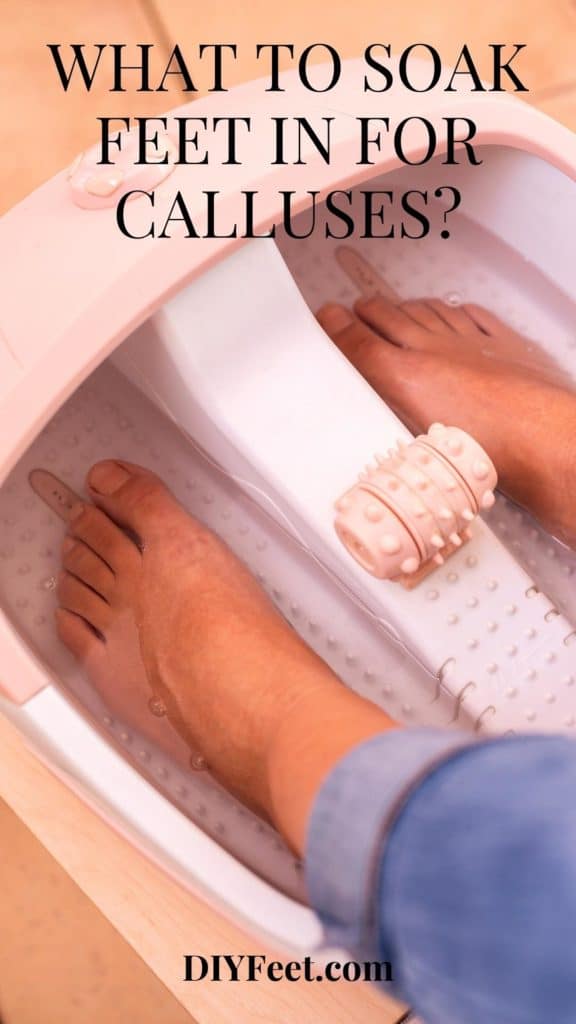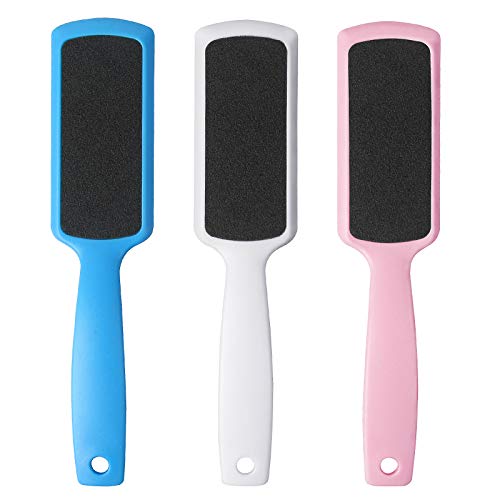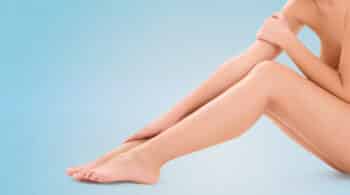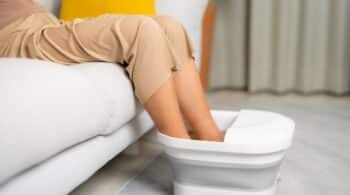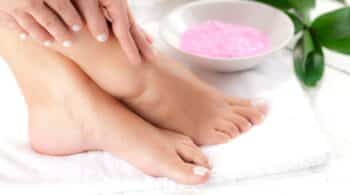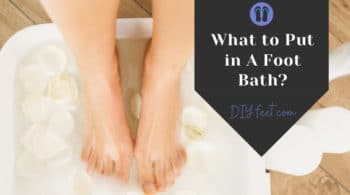What to Soak Feet in For Calluses? Calluses don’t just look bad, they can also be painful to walk on. Everyone gets calluses at some point in their life, whether this is from unsupportive shoes or walking barefoot on rough surfaces. Still, this doesn’t mean that you should leave your feet untreated.
There are a ton of ways you can help soften up your feet and get rid of calluses. You don’t even have to go to a doctor to do these treatments. We’ll introduce you to some easy foot care treatments for calluses here. They are effective and simple to do at home!
What Are Calluses?
Before we talk about getting rid of calluses, let’s discuss what they are. Calluses are basically just a build-up of skin on the feet. Your skin hardens and grows extra layers due to excessive amounts of pressure or friction. People usually get these skin formations from walking barefoot, or from wearing shoes that are not good for their feet.
Explanation of calluses
Calluses form as a protective response to friction and pressure, typically in areas that bear most of our weight. The outer layer of the skin accumulates dead skin cells, which become compacted and thickened, forming calluses. While calluses generally pose no harm, they can cause discomfort or pain if left untreated.
Causes of calluses
Wearing tight shoes, high heels, or those with insufficient padding can increase the likelihood of developing calluses. Moreover, engaging in activities that exert excessive pressure on the feet, such as running or walking long distances, may also contribute to their formation.
Top Foot Care Treatments For Calluses
1. Use a Pumice Stone For Dead Skin on Feet Soak your feet in a soothing solution to effectively tackle calluses and dead skin. Discover what to soak feet in for calluses and achieve smoother, healthier feet with our easy foot care treatments. Discover what to soak feet in for calluses and achieve smoother, healthier feet with our easy foot care treatments. Say goodbye to dead skin and calluses with a soothing solution and the use of a pumice stone.
Pumice stones are one of the most popular treatments for calluses. You can get one of these stones in almost any store. All you have to do to get rid of dead skin and calluses with this tool is to rub the stone gently on your feet. Pumice products are made from volcanic rocks and get rid of calluses quickly.
2. Enjoy a Foot Soak
If you don’t want to use a pumice stone, though, you can always apply Vaseline jelly. Vaseline jelly is the ultimate moisturizing product for your feet. It’s affordable and is simple to use on your calluses.
Just apply the jelly to your feet to soften them up and get rid of calluses. It is best to use this after a bath, though. Put it on, then wrap your feet in saran wrap so that the moisture stays locked in.
3. Apply Foot Cream
Foot cream can be another great option, as well. However, heavily medicated foot creams can often be harsh on the feet. So, we recommend getting something less potent at your local drug store. You want a lotion with lactic acid in it, this way the calluses are slowly removed. But overall, this is a very effective treatment option for calluses.
4. Find a Foot File Product
In addition to creams and moisturizing oils, you can also find foot files specifically made to fight off calluses. There are a ton of these products available from Ped eggs, manual foot files, and even electronic foot filers. Foot files, are pain-free and can be used directly on your skin before or after you take a shower. They help file down calluses successfully and quickly.
5. Put on a Pedi Pad
Our final treatment option for calluses involves Pedi pads. Pedi pads are small felt pads that lay overtop your calluses. These products take the pressure off of your calluses and allow them to shrink down.
What to Soak Feet in For Calluses?
If you’re looking for effective ways to treat calluses on your feet, soaking them regularly can be an essential part of your skincare routine. There are several common soaks that you can try, each with its own benefits and properties.
Epsom Salt Soak
One popular soak for calluses is an Epsom salt soak. Epsom salt contains magnesium sulfate, which can help soften the skin and reduce inflammation. To prepare the soak, fill a basin with warm water and add a handful of Epsom salt. Soak your feet for about 20 minutes, then gently scrub the calluses with a pumice stone.
Baking Soda Soak
Baking soda is known for its exfoliating properties, making it an excellent soak for calluses. Fill a basin with warm water and add 2-3 tablespoons of baking soda. Soak your feet for 15-20 minutes, then gently scrub the calluses with a pumice stone.
Apple Cider Vinegar Soak
Another effective soak for calluses is an apple cider vinegar soak. The acidity in apple cider vinegar can help soften and exfoliate the skin. Mix equal parts of apple cider vinegar and warm water in a basin. Soak your feet for 15-20 minutes, then gently scrub the calluses with a pumice stone.
Remember to moisturize your feet after each soak to keep the skin soft and supple.
Benefits of Soaking Feet for Calluses
One effective way to treat calluses on your feet is by soaking them. Soaking your feet in warm water can provide numerous benefits in the treatment of calluses.
Softening the calluses
When you soak your feet, the warm water helps to soften the callus, making it easier to remove. The moisture from the water penetrates the thickened skin, hydrating it and allowing it to become more pliable. This softening effect can make the callus less painful and more manageable.
Reducing pain and discomfort
Soaking your feet in warm water can also help to relieve the pain and discomfort associated with calluses. The warm water soothes the affected area and can provide temporary relief from any soreness or tenderness.
Enhancing the effectiveness of other treatments
Soaking your feet prior to using other treatments, such as exfoliating or applying creams, can enhance their effectiveness. By softening the callus, any subsequent treatments can penetrate deeper into the skin, making them more effective in reducing the size and thickness of the callus.
Incorporating regular foot soaking into your callus treatment routine can contribute to softer and more comfortable feet.
Instructions for Soaking Feet
Preparing the soak
To effectively treat corns and calluses on your feet, it is important to soak them in the right solution. Begin by filling a basin with warm water, ensuring that it is deep enough to cover your feet comfortably. Add a gentle soap or mild shampoo to create a soapy mixture.
You can also incorporate soothing ingredients like Epsom salt or essential oils for added benefits. Stir the water to dissolve the ingredients and create a well-mixed solution.
Soaking duration and frequency
Once the soak is ready, place your feet in the basin and soak them for about 15 to 20 minutes. This duration allows the calluses to soften and become more manageable. Repeat this process two to three times a week to achieve optimal results.
Over-soaking can strip the skin of natural oils, so it’s essential to strike the right balance for your skin type.
Additional tips for optimal results
While soaking your feet, consider using a pumice stone or a foot file to gently exfoliate the callused skin. This will aid in the removal process and leave your feet feeling smoother.
After soaking, make sure to thoroughly dry your feet and apply a moisturizing cream or lotion to keep the skin hydrated. Remember to wear comfortable socks and shoes to prevent friction and further callus formation.
Incorporating these simple steps into your foot care routine and regularly soaking your feet will help soften calluses and promote healthier, happier feet.
Precautions and Possible Side Effects
Consulting a healthcare professional
Before attempting any home remedies or soaking treatments for calluses, it is important to consult a healthcare professional. They can provide insight into the severity of your calluses and recommend the best course of action. Calluses can sometimes be a symptom of an underlying health condition, so it is crucial to rule out any potential medical issues before proceeding with any treatments.
Avoiding hot water
When soaking your feet to soften calluses, it is essential to avoid using hot water. Hot water can cause burns or scalding, which can lead to further damage to your skin. Instead, opt for warm water that is comfortable to the touch. This will help to soften the calluses without risking injury.
Monitoring for allergic reactions
While some home remedies for soaking feet in callus removal may be natural or gentle, it is still possible to experience allergic reactions. Before commencing any soaking treatments, test the mixture on a small patch of skin to ensure there is no adverse reaction. If you notice any redness, itching, or swelling, discontinue use immediately and consult a healthcare professional.
Remember, it is important to take precautions and consult a professional before attempting any treatments for calluses. By following these guidelines, you can help minimize potential risks and ensure a safe and effective soaking experience for your feet.
Conclusion
In conclusion, soaking your feet in various solutions can provide numerous benefits for calluses. As we discussed, a warm water soak with added Epsom salt can help soften the thickened skin and reduce inflammation, making it easier for you to remove the calluses. Additionally, a vinegar soak can be effective in battling bacteria and fungi, which are often present on callused feet.
Another option is to try a milk soak, which contains lactic acid that can gently exfoliate the dead skin cells and moisturize the area. Ultimately, the best soaking solution for your calluses may differ from what works for others. Therefore, we encourage you to experiment with different soaks and find the one that gives you the desired results. Remember to consult a healthcare professional if you have any concerns or medical conditions before trying any home remedies.
So go ahead, give it a try, and say goodbye to those stubborn calluses!
Share on Pinterest
